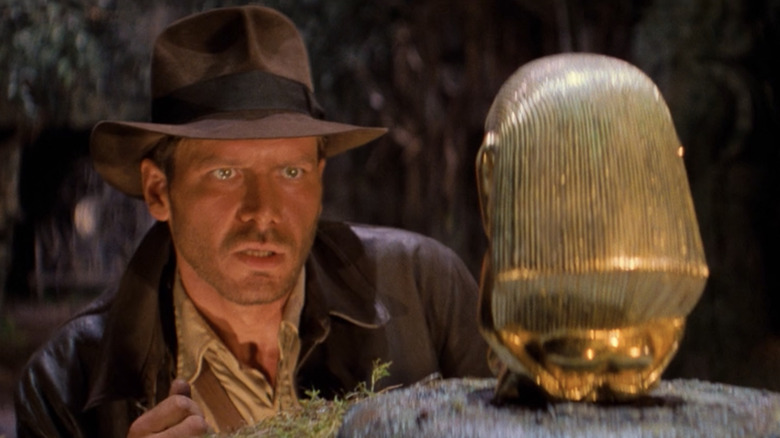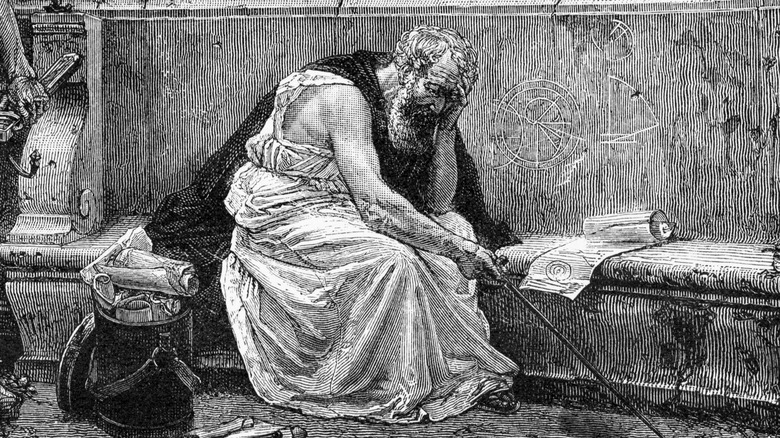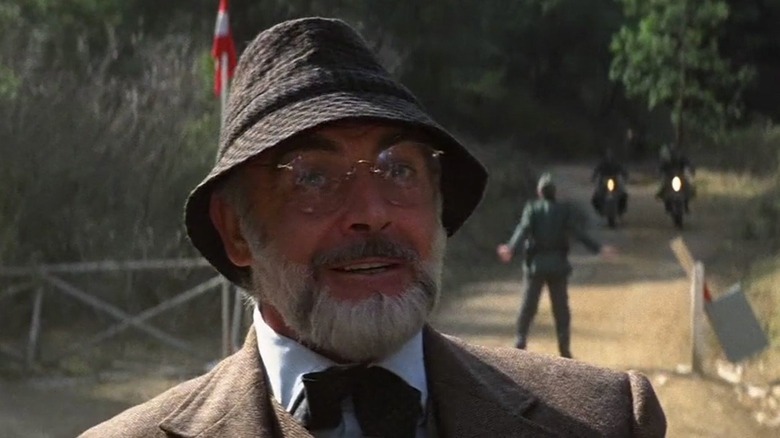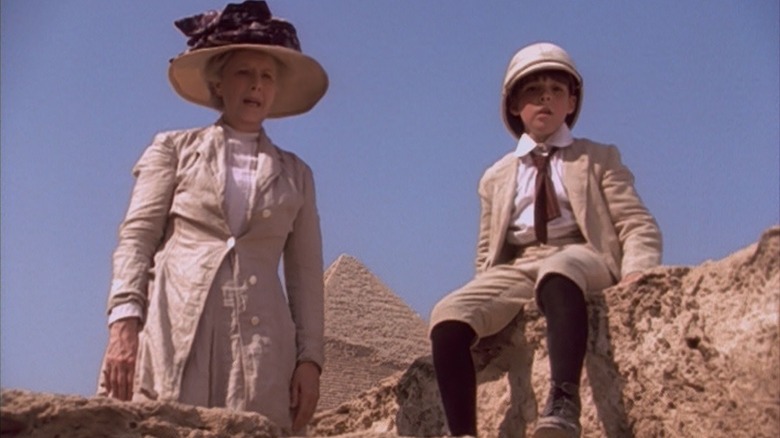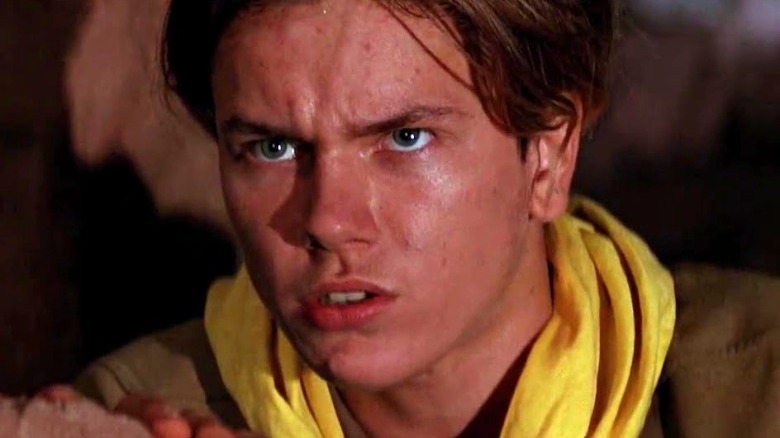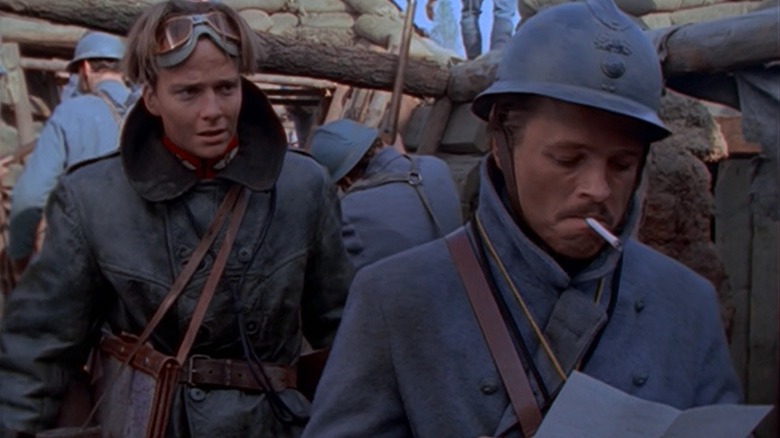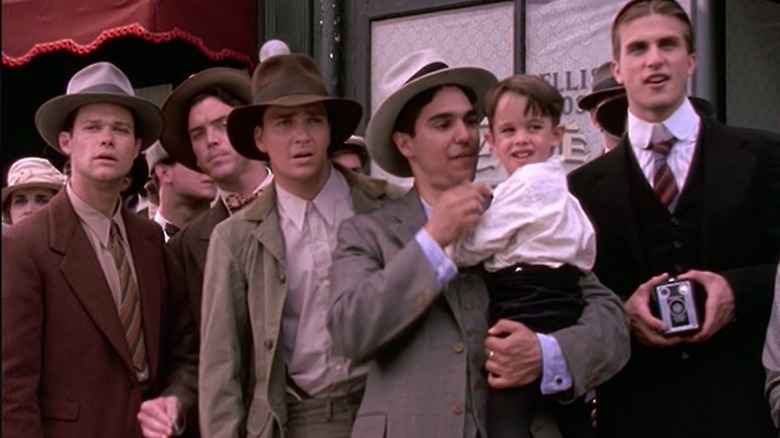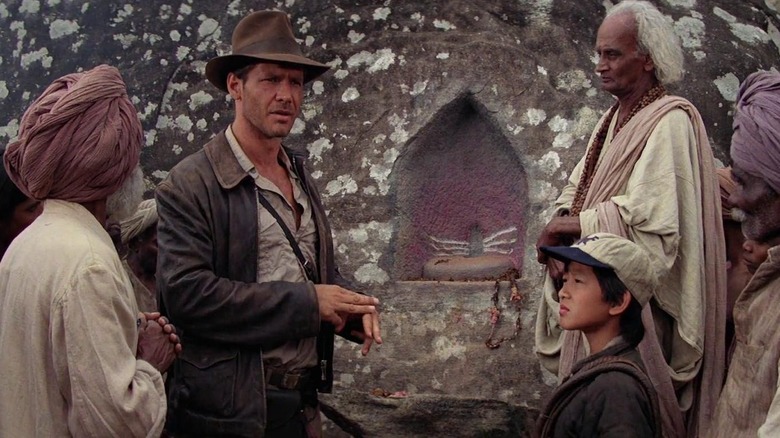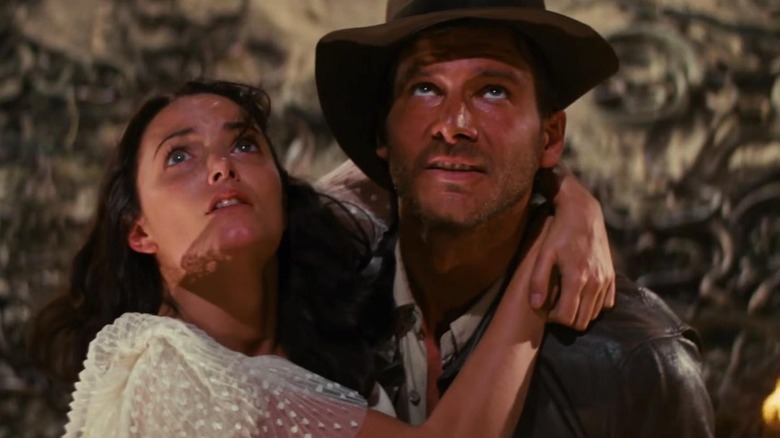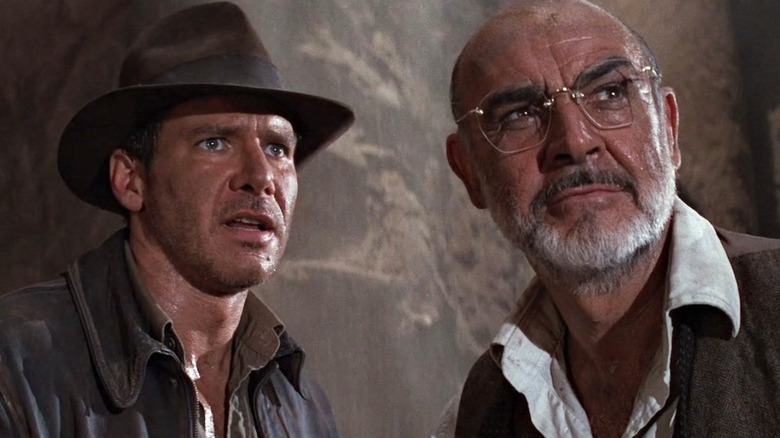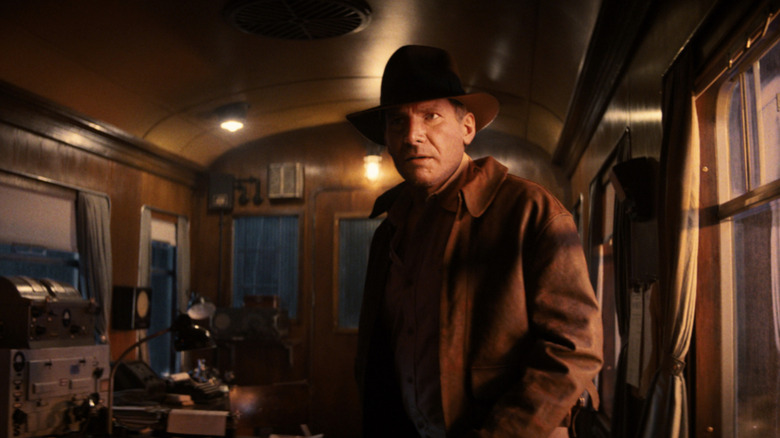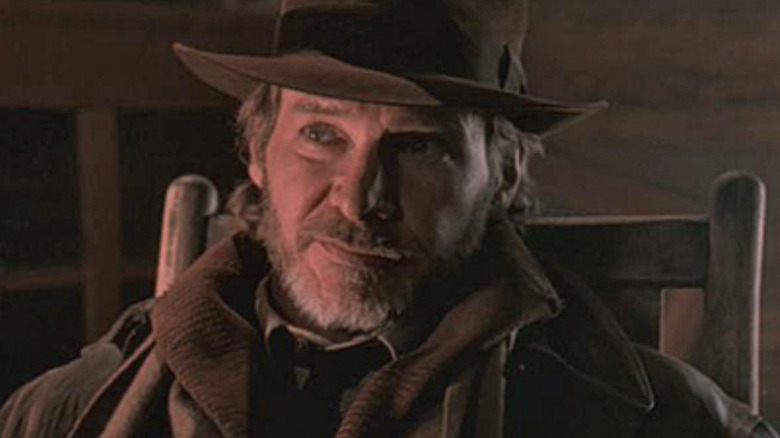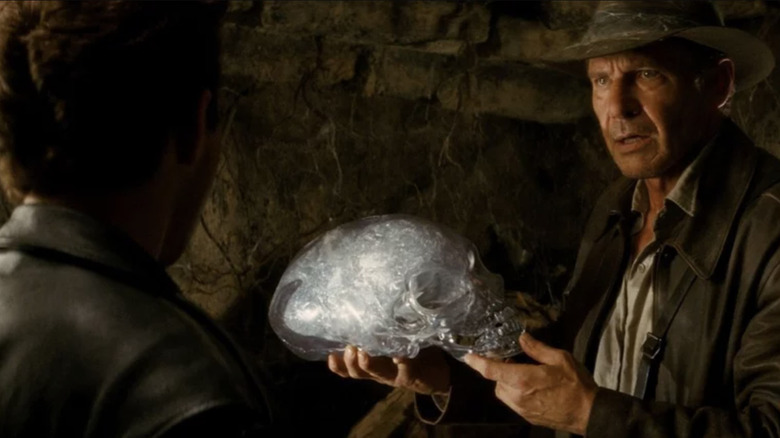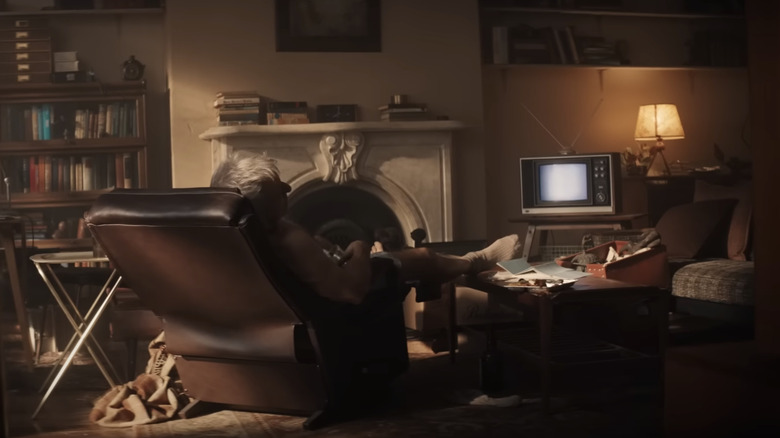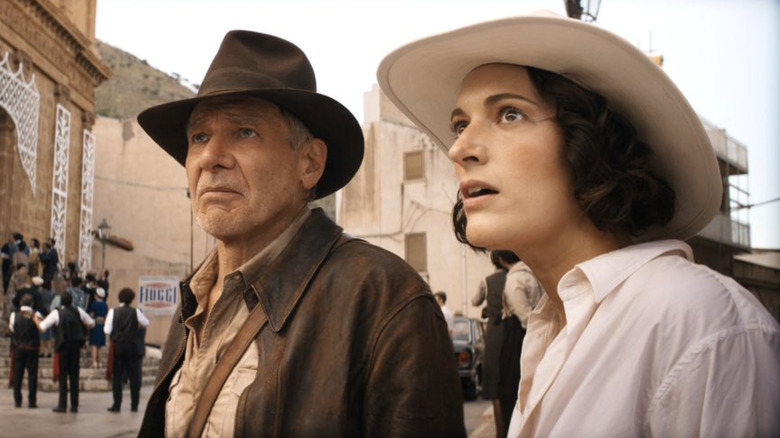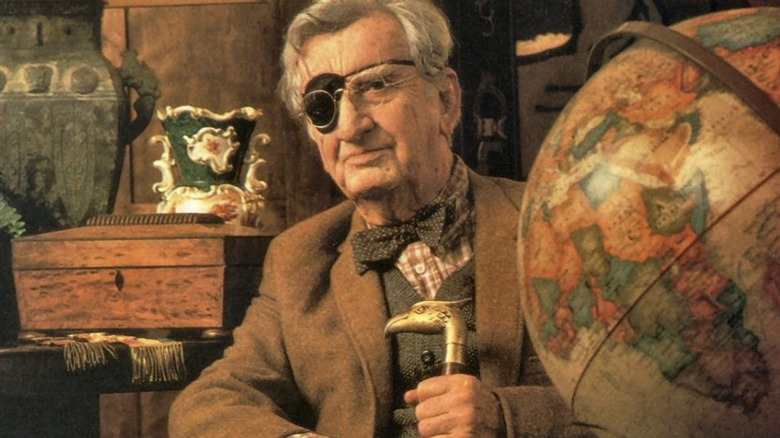The Entire Indiana Jones Timeline Explained
Contains spoilers for "Indiana Jones and the Dial of Destiny"
Few could have imagined when Indiana Jones burst into our collective consciousness with 1981's "Raiders of the Lost Ark" that he'd become a figure of almost mythical proportions, spawning an entire universe that would still be going strong over 40 years later. Certainly not director Steven Spielberg, who told the New York Times upon the movie's release that he scaled back producer George Lucas's ambitious script, saying, "I decided not to shoot for a masterpiece, but to make a good movie that told George's story very well."
It just goes to show how incredible a character Indiana Jones is, because, despite Spielberg's best efforts, a masterpiece is what he got. Since that first film, Indy's starred in four more theatrical adventures, including his final romp, "Indiana Jones and the Dial of Destiny." He's appeared in video games, comic books, a series of novels, and even had his own show in the early '90s ("The Young Indiana Jones Chronicles"). He's fought Nazis, Soviets, and grave robbers; in fact, his villains are almost as famous as Indy himself.
Though not all fans may realize it, the world of Indiana Jones is far more expansive than the films, and it can take some work to sort through his life. Of course, it doesn't help that the movies aren't quite in chronological order. But that's why we're here to help set his timeline in order and explain Indiana Jones' sometimes messy life.
212 B.C. -- Archimedes invents the Antikythera
Far back in ancient Greece, the great mathematician Archimedes invents a device known as the Antikythera, which can locate fissures in time. The device, eventually known as Archimedes' Dial, aka the Dial of Destiny, is rumored to have time-displacing abilities and is lost years after the Siege of Syracuse, which occurs in 213-212 B.C. But, as it turns out, Archimedes invents the Dial as a means to send for help, to protect his home from the invading Romans.
The inventor has already built plenty of weapons to protect the city, but they aren't enough. Eventually, the city falls, but Archimedes is spared by Rome. Before the Siege is over, however, an aircraft mysteriously arrives through a temporal portal, bringing Indiana Jones, his goddaughter Helena, and a few Nazis with him from the year 1969 A.D. Having been gravely injured by his adversaries, Indy decides that it's his time to die and that he'd like to do so while experiencing the same history he'd fought to teach and uncover throughout his life.
Of course, Indy fails to consider any possible ramifications of his remaining in the past, so he is quickly knocked out by his goddaughter. Though Indy and his allies make it back to their time in the 20th century, the Nazis who brought them there through the use of the Antikythera are killed by the Romans, who believe their plane to be a monstrous dragon.
1872 -1899 -- The Jones family
Much of who Indiana Jones is comes, for better or worse, from his parents. His dad, Henry Walton Jones, Sr. is born in 1872 in Scotland, while his mother, Anna Mary Jones, is born to a wealthy family in Virginia. Indy's dad seems to have a volatile life from the beginning, admitting to his son in the 1996 TV movie "Young Indiana Jones: Travels with Father" that he ran away from home a time or two.
Henry Sr., though, is smart as a whip, and in time he attends and graduates from Oxford University. This is where, according to "Indiana Jones and the Last Crusade," Henry meets and befriends Marcus Brody, who'd go on to hire Indiana at Marshall College and even accompany the Jones men on their quest for the Grail. That is, when he isn't getting lost in his own museum.
Henry and Anna meet and fall in love after he graduates from Oxford. They move to Connecticut and Henry becomes a professor of medieval literature. With that background, it's no wonder the senior Jones becomes obsessed with the Holy Grail. His Grail diary begins, according to "Indiana Jones: The Ultimate Guide," back during his college days as little more than a composite of all the literary myths and legends that point, or so the professor believes, towards the Grail's location. It takes decades to grow into the roadmap so desperately sought by the Nazis. Then finally, on July 1, 1899, Henry Walton Jones Jr. is born.
1908 - 1910 -- Young Indiana Jones
Henry Jones Jr. doesn't keep his name for long. His parents make the mistake of introducing him to the new family dog, an Alaskan Malamute, when the tot is still in the crib. Henry is so enamored with the dog that, by the time he's six, according to "The Ultimate Guide," he'll adopt the dog's name, Indiana, as his own.
Part of Indy rejecting his own name, though, comes from him wanting out from under his father's shadow. The two never get along well, with Anna Jones doing her best to act as a calming force as the three of them travel the world on a lecture circuit. Those travels, from 1908 to 1910, make up the earliest years of "The Young Indiana Jones Chronicles." The circuit takes the Jones family from Egypt's Valley of Kings and Tangiers, Morocco, to Vienna and Beijing.
Indy is practically the Forrest Gump of the archeological world, even when he's a kid. His first adventures involve meeting Thomas Edward Lawrence, who Indy just calls "Ned." History, on the other hand, remembers him as Lawrence of Arabia. Indiana also runs across Howard Carter, the archeologist who discovered King Tut's tomb, and later, befriends Teddy Roosevelt himself in Kirinyaga in "British East Africa," a territory that encompasses Kenya, Uganda, Zanzibar and Tanzania. Is it any wonder that the boy would decide to go his own way and become an archeologist, rather than follow in his father's literary footsteps?
1912 -- The Boy Scout
Indy's relationship with his father is always strained — so much so that an entire adventure of "The Young Indiana Jones Chronicles" revolves around his mom urging the two Henrys to spend time together and bond. The family works for its first 13 years, but barely. When Anna dies in 1912, Indy and his father struggle to even communicate. It doesn't help that Henry moves them from Princeton to Utah, which is where they're living in the opening of "Indiana Jones and the Last Crusade."
This is where we really see much of Indiana (played by the late River Phoenix) as we'd come to know him, emerging at the tender age of 13. The precocious Boy Scout comes upon a group of thieves pilfering the Cross of Coronado and he takes it upon himself to get it back. After all, it belongs in a museum. During this mini-adventure, Indiana cracks his first whip while trying to tame a lion after falling into the big cat's train car, and gains his crippling fear of snakes after falling into a snake pit.
In the end, Indy even gains his trademark fedora, given to him by one of the thieves as an admission of respect for his young adversary. That fedora's even more impressive, knowing that Indy's managed to hold onto it for decades, through countless adventures and near-death experiences. Or maybe he just likes the way it looks so much that he replaces it a few hundred times.
1916 - 1919 -- The war years
Four years pass and Indiana grows from idealistic teen to ... slightly older idealistic teen. He can't shake his tendency to stumble upon the greatest historical figures of the 20th century, though, and during his "Spring Break Adventure" (by now, you probably noticed that "The Young Indiana Jones Chronicles" were pretty spot-on with their episode names) in New Mexico, he and his cousin Frank are kidnapped by Mexican Revolution general Pancho Villa.
While there, he meets and becomes fast friends with Belgian Rémy Baudouin and by the end of the adventure, the two decide to join the fighting in World War I. Indy's had better ideas. In "Trenches of Hell," he lies about his age and adopts the name Henri Défense. "Henri" and Rémy get a firsthand taste of the trench warfare at Flanders and witness the horrors of the Battle of Somme. By the time they move on from Europe to Africa, they've had just about enough war.
When they find a treasure map on the body of a dead soldier in "Treasure of the Peacock Eye," they figure it's time for fortune and glory by finding the fabled diamond named, as one might guess, the Eye of the Peacock. They don't succeed, but in the end, Indy realizes it's time to get back to his life in America and fulfill his ambition to become an archeologist. He's let greed get in the way of his dreams and ideals for too long.
1920 - 1926 -- University studies
After returning from the war, Indiana resumes his schooling, studying archeology at the University of Chicago. Over the course of several episodes of "The Young Indiana Jones Chronicles," Indy meets everyone from his roommate Elliot Ness to reporter Ernest Hemingway and hoodlum Al Capone. Indy also first meets René Belloq during this time, according to "The Ultimate Guide Book." The two competing archeologists go on to clash a number of times over the years, so that by the time they run into each other in "Raiders of the Lost Ark," they're all but mortal enemies.
But perhaps most importantly for Indiana, as we learn in "Kingdom of the Crystal Skull" and "Raiders of the Lost Ark," this is when he first meets Harold Oxley and studies under Marion Ravenwood's father, Abner. Abner is a treasure hunter and archeologist obsessed with the Ark of the Covenant, long before the Nazis ever try searching for it. Indiana is his favorite student.
Abner becomes something of a father figure for Indiana at this point, a pattern that the archeologist repeats over and over again throughout his life. With his relationship with his actual father so strained, it's no wonder that Indy searches out replacements everywhere he goes. That surrogate relationship comes to a close, however, after Indiana woos Marion. Their relationship collapses in less than a year and the fallout costs Indy not just Marion, but also Abner and Oxley for a time.
1935 -- The Temple of Doom
By the time of Indiana's first film escapade (chronologically, anyway) the archeologist is already a seasoned adventurer. By 1935, he's been traveling the world for over a quarter of a century. Though he's later a teacher at Marshall College, in 1935, he's a professor at Princeton. The Indiana Jones that we first meet in Shanghai is already a capable pro with allies all over the world — allies like Wu Han and Short Round.
Indy finds himself in China, having tracked down the priceless Eye of the Peacock once more. That's the diamond he's after, according to "The Ultimate Guide," at the beginning of "Indiana Jones and the Temple of Doom." Local crime lord Lao Che has it, and Indy apparently just can't let go of his obsession. At least now he wants to preserve the artifact, rather than profit from it. Then, as usual, things go horribly wrong.
For one thing, Indy doesn't get the diamond. Instead, Wu Han is murdered, lounge singer Willie Scott annoyingly tags along, and their plane goes down in India after being sabotaged by Lao Che. But really, that's all in a day's work for Indy — though tackling child slavery, a murderous, brainwashing Thugee cult, and cult leader Mola Ram, who is capable of tearing hearts out with his bare hands, ends up being a bit more than the norm. After freeing the young, enslaved locals, Indiana and Willie find love. Well, for about a year anyway.
1936 -- Raiders of the Lost Ark
Though "Raiders of the Lost Ark" is the second film in the timeline, it's the first of the series. This movie started it all, building the world, setting the tone, and pitting Indy against the Nazis for the first time. Indy was ahead of the times, punching Nazis years before his own country ever decided to take them on, and even before World War II officially started in 1939.
Both Willie and Short Round are gone by now with no explanation. It makes sense, seeing as how they hadn't been created yet, but it's frustrating from a continuity standpoint. But Willie and Indy must have parted on decent terms since he has a framed photo of her in his home in "Indiana Jones and the Kingdom of the Crystal Skull." And Short Round, according to 2008's "The Lost Journal of Indiana Jones," follows in Indy's footsteps and tracks the Eye of the Peacock down in 1957.
In "Raiders of the Lost Ark," Indy is contacted by the U.S. government after they learn the Nazis are interested in Indy's old mentor, Professor Ravenwood. They're after the Ark of the Covenant and Indy heads out to beat them to the punch. In the process, he reconnects with Marion and battles it out with the evil Belloq one final time, before ending the film a bit wiser about the power of the artifacts he searches for. If you're not careful, they could melt your face off.
1938 -- The Last Crusade
By 1938, Marion and Indiana have experienced another falling out, apparently bad enough that she never tells him about their newborn son, Mutt. But that's a problem for another movie. Indy's father, Henry, is this movie's problem. The elder Jones has obsessed over the famed Holy Grail for over four decades — for far longer, even, than our favorite archeologist has been alive. No wonder their relationship is so damaged.
In all that time, Jones, Sr. has kept a diary that dates back to his time in Oxford. Back then, his search for the Grail was little more than a hobby, but by 1938 it's all-consuming. That obsession catches the eyes of the Nazis (though Henry doesn't realize it when hired by art collector Walter Donovan). They're back to their old tricks, trying to collect objects of power and twist them to their own perverse use.
When Henry realizes what's going on, he ships his diary off to his estranged son, and "Indiana Jones and the Last Crusade" kicks into high gear. Indy picks up his father's quest — ostensibly only to find his dad, but he'd be lying if he didn't admit that the archeological quest didn't give him a thrill. As does the lovely-but-deadly Elsa Schneider. By the end of their adventure, the Joneses both find and lose the Holy Grail, but not before Indy uses it to save his father's life, reconciling their relationship and completing their life-long quest.
1944 -- Searching for the Holy Lance
Of course, "The Last Crusade" isn't exactly the last adventure that Indy would embark on. In fact, he has a few more good years up his sleeve. At the tail-end of World War II, Indy and his friend, Professor Basil Shaw of Oxford, infiltrate Nazi-occupied Europe to retrieve the famed Lance of Longinus, also known as the Holy Lance or the Spear of Destiny. This Roman spear supposedly pierced the side of Jesus Christ and supposedly gives its wielder incredible powers.
No wonder the Nazis are also looking for it. If they can't get the Ark of the Covenant or the Holy Grail, this is the next best thing. Eventually, the Nazis capture Jones, and later Shaw, but one Nazi, physicist Jürgen Voller, discovers a different prize to present to Hitler: the Dial of Archimedes. Or, at least half of it. While rescuing Shaw, Indy retrieves the Dial — though only after discovering the Nazis' Holy Lance is a fake (though he'll find the real one eventually) — and evades capture just before the Allies attack, seemingly killing Voller.
Of course, the best villains never die so easily. Voller survives and vows to retrieve the Dial at any cost. After the end of the war, Voller and a number of other Nazi scientists are conscribed into service to the United States military, aiding them in advancing U.S. military technology during the Cold War. But as they'd soon learn, never trust a Nazi.
1951 -- Indy takes the Antikythera from Basil Shaw
After the war, Indy and Shaw return to their respective homes, Shaw taking the Antikythera with him. In only a matter of years, Shaw has became obsessed with the Dial and the stories surrounding it: namely its ability to send one through time. Of course, Indy doesn't believe any of that "nonsense." And why would he? It's not like he's ever seen anything supernatural occur before his eyes. But though he doesn't believe in the Dial's power, Indy cares deeply for his friend and his decaying mind.
A year after he recovers a relic in Wyoming, Indy flies to Oxford and takes the half of the Dial from Shaw that they'd uncovered, vowing to destroy it. But, in true Indiana Jones fashion (he's an archeologist, remember?), the famed adventurer has no intention of actually destroying the Antikythera piece, and instead hides it away from the world, far out of Shaw's, and the Nazis', reach. Before leaving, he tells Shaw's daughter Helena, who he affectionately calls "Wombat," that he'll call to check in, driving away with the thing that broke her father. Though Indy is Helena's godfather, that heartbreaking night is the last he sees of her for 18 years.
Tragically, Basil Shaw dies a few years later. He's never the same after losing the Dial, which he continues to obsess over. He writes a journal that he later passes to Helena.
1957 -- The Kingdom of the Crystal Skull
Only a few years after retrieving part of the Archimedes Dial, Indiana Jones is back at it again, on a new adventure that takes him and his then-partner George "Mac" McHale to Area 51. Captured by the Soviets, led by Irina Spalko, Jones takes them to the corpse of an alien being found after a UFO crash-landed in Roswell, New Mexico. After being betrayed by Mac, and almost blown up during a nuclear test by the U.S. government, Indy is put on an indefinite leave by his university, Marshall College, since he's been deemed a possible spy.
It's then, in "Indiana Jones and the Kingdom of the Crystal Skull," that Mutt Williams arrives on the scene, hoping to enlist the professor in helping him save his mother, Marion Ravenwood. Yes, that Marion Ravenwood. Over the course of his quest, Indy is forced to help the Soviets in their search for the famed Crystal Skull, which will lead them to a treasure trove filled with power. While on this quest, which also reunites Indy with his old college friend Harold Oxley, the adventurer finally learns that Mutt is his and Marion's son, Henry Jones III.
After the Skull is reunited with its corpse, it resurrects as an extra-dimensional life form, which kills Spalko before returning to its home dimension. To celebrate, Indy and Marion finally tie the knot, uniting the three Joneses together as one big happy family — for a while at least.
Early '60s -- Indy and the kids go off the rails
After the death of her father, Helena Shaw slowly descends into the world of thievery and con-artistry, becoming something of a criminal herself in the process. As she continues to explore her father's own obsessions with the Antikythera, she gets involved with plenty of shady characters and ends up owing many of them obscene amounts of money. At one point, she's even briefly engaged before selling off the ring for some cash. Though a thief herself, Helena is nearly robbed by the young street orphan Teddy Kumar, who, like Short Round with Indy decades prior, becomes her unofficial partner/side-kick.
On the Jones home front, in an effort to irritate his father, Mutt Williams joins up with the U.S. Army to fight during the Vietnam War. But tragedy strikes when Mutt is killed in action, which breaks Indy and drives him into retirement at his now-home, Hunter College in New York City. Mutt's death drives Indy and Marion apart, and after trying for a time to save their marriage, they're soon separated. Indy ends up living (and drinking) alone, while Marion grieves her son's death elsewhere.
As Indy mourns for his son, the Nazi physicist Jürgen Voller, now called Lehrer Schmidt to hide his identity, works on the Apollo mission that eventually sends America to the moon. During this time, he continues his own search for the Dial, which puts him on Helena's trail.
1969 -- Indy's final adventure
Most of the events of the final installment of the franchise, "Indiana Jones and the Dial of Destiny," take place in 1969. Indiana Jones is officially retiring, and on his last day at Hunter College, Helena arrives and pitches him the idea of one last adventure to find the Antikythera. Except she's lying: Helena wants the Dial for her own reasons (mostly financial gain), and so she steals it from Indy, forcing the archeologist to come out of retirement to find her.
Their adventures take them all over Europe as they're chased by Voller and his Nazi stooges, who kill Indy's friend Renaldo in the process. Indy and Helena eventually discover the location of the other half of the Dial in Sicily and unite the pieces before Voller shows up. Voller reveals his plan to use the Antikythera to time-travel to 1939 and assassinate Hitler, taking over the Third Reich. Stupidly, Voller doesn't account for the past 2,000 years of geographical changes, sending him, Indy, Helena, and the gang to the Siege of Syracuse in 212 B.C.
Upon returning home, Jones wakes up to Marion walking in the door, and after being reunited with Helena, Teddy, and Sallah, the two decide to give their marriage another shot. Hopefully, the fourth time is the charm. After reenacting a scene from "Raiders of the Lost Ark," Indy and Marion embrace, proving that their final adventures together aren't over just yet.
Early 1990s -- Bookending the saga
Although "Dial of Destiny" is the final chapter of the "Indiana Jones" saga, chronologically speaking there's another time period of note. In many episodes of "The Young Indiana Jones Chronicles," the stories of Indy's youth are bookended by a eyepatch-sporting Indiana Jones in his 90s, played by George Hall. In these bookends, we discover that Jones lived until at least the early 1990s (the series ran from 1992-1993) and saw his grandchildren and great-grandchildren grow up.
Given that George Lucas was behind the show's 28 episodes (and four made-for-TV movies), it's likely that this still is considered "Indiana Jones" canon, even if it seems to contradict what we know from the films. By the end of "Dial of Destiny," Marion is Jones' only known next-of-kin, but that doesn't mean there aren't other Joneses out there. The five movies can only cover so much ground, after all. While we learn that Mutt is Indy's son in "Kingdom of the Crystal Skull," the television series suggests that Indy had a daughter named Sophie as well.
Given Jones' romantic history in both the films and the TV show, it's entirely possible that the adventuring archeologist had other children that he didn't quite know about. Maybe in the years between 1969 and 1992, he discovers another child of his and invests in her life. According to "The Young Indiana Jones Chronicles," Indy had three grandchildren and two great-grandchildren, so it looks like he found that happy family life after all.
